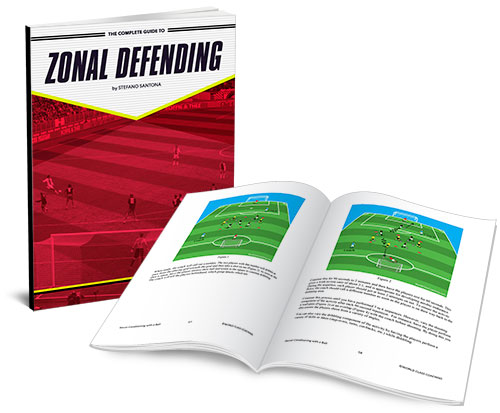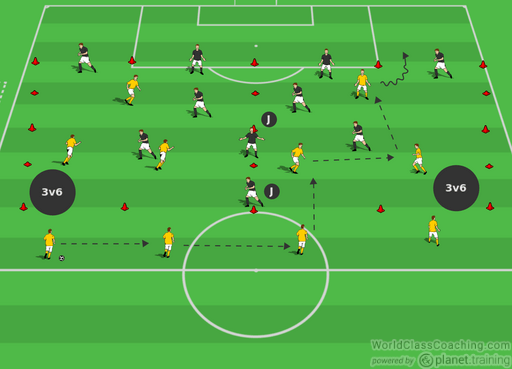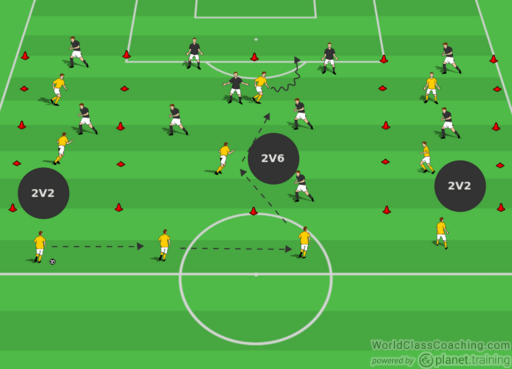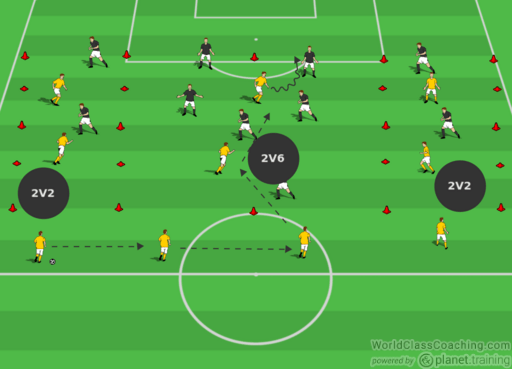WORLD CLASS COACHING
The Complete Guide to Zonal Defending
By Stefano Santona

TABLE OF CONTENTS
Part Three
ZONAL DEFENDING IN THE 4-5-1
ZONAL DEFENDING IN THE 4-2-3-1
CONCLUSION
4-5-1 ZONAL DEFENDING EXERCISES
4-5-1 VS 4-4-2 VERTICAL LANES (2 SPACES)

Area Size:
Different geometric sizes depending on age and technical quality of the players.
If it is possible we can play this exercise in the space included between the box and the midfield line.
Time:
15-20 minutes
Objectives:
• Never lose your zone and your gate;
• To pass the ball quick through the gate;
• To stop the pass if it is your gate;
• To choose the right moment to pass;
• Develop the ability to attack outnumbered;
• To pass the ball to a free player;
• Just a little bit of work involving the lateral vision;
• Just a little bit of work on change of direction;
• Develop the ability to control your zone;
• Understand the importance of the players in the middle of the field (marked with J in the picture);
Execution:
This exercise is about the ability to pass the ball through a gate (it is like the zone that defender has to cover during the match).
This is good to train 451 against 442.
It is possible to play this game with two different teams. The team that scores more points driving through the gates wins the challenge.
Offensive team has to find a space and, to score a point, has to drive the ball behind the defense line, while the defensive team has to close all the gates.
It is good to play the game in 25-40 seconds.
4-5-1 VS 4-3-3 VERTICAL LANES (3 SPACES)

Area Size:
Different geometric sizes depending on age and technical quality of the players.
If it is possible we can play this exercise in the space included between the box and the midfield line.
Time:
15-20 minutes
Objectives:
• Never lose your zone and your gate;
• To pass the ball quick through the gate;
• To stop the pass if it is your gate;
• To choose the right moment to pass;
• Develop the ability to attack outnumbered;
• To pass the ball to a free player;
• Just a little bit of work involving the lateral vision;
• Just a little bit of work on change of direction;
• Develop the ability to control your zone;
Execution:
This exercise is about the ability to pass the ball through a gate (it is like the zone that defender has to cover during the match).
This is good to train 451 against 433.
It is possible to play this game with two different teams. The team that scores more points driving through the gates wins the challenge.
Offensive team has to find a space and, to score a point, has to drive the ball behind the defense line, while the defensive team has to close all the gates.
It is good to play the game in 25-40 seconds.
4-2-3-1 ZONAL DEFENDING EXERCISES
4-2-3-1 VS 4-4-2 VERTICAL LANES (2 SPACES)

Area Size:
Different geometric sizes depending on age and technical quality of the players.
If it is possible we can play this exercise in the space included between the box and the midfield line.
Time:
15-20 minutes
Objectives:
• Never lose your zone and your gate;
• To pass the ball quick through the gate;
• To stop the pass if it is your gate;
• To choose the right moment to pass;
• Develop the ability to attack outnumbered;
• To pass the ball to a free player;
• Just a little bit of work involving the lateral vision;
• Just a little bit of work on change of direction;
• Develop the ability to control your zone;
• Understand the importance of the players in the middle of the field (marked with J in the picture);
Execution:
This exercise is about the ability to pass the ball through a gate (it is like the zone that defender has to cover during the match).
This is good to train 4231 against 442.
It is possible to play this game with two different teams. The team that scores more points driving through the gates wins the challenge.
Offensive team has to find a space and, to score a point, has to drive the ball behind the defense line, while the defensive team has to close all the gates.
It is good to play the game in 25-40 seconds.
4-2-3-1 VS 4-3-3 VERTICAL LANES (3 SPACES)

Area Size:
Different geometric sizes depending on age and technical quality of the players.
If it is possible we can play this exercise in the space included between the box and the midfield line.
Time:
15-20 minutes
Objectives:
• Never lose your zone and your gate;
• To pass the ball quick through the gate;
• To stop the pass if it is your gate;
• To choose the right moment to pass;
• Develop the ability to attack outnumbered;
• To pass the ball to a free player;
• Just a little bit of work involving the lateral vision;
• Just a little bit of work on change of direction;
• Develop the ability to control your zone;
Execution:
This exercise is about the ability to pass the ball through a gate (it is like the zone that defender has to cover during the match).
This is good to train 4231 against 433.
It is possible to play this game with two different teams. The team that scores more points driving through the gates wins the challenge.
Offensive team has to find a space and, to score a point, has to drive the ball behind the defense line, while the defensive team has to close all the gates.
It is good to play the game in 25-40 seconds.
CONCLUSION
It is often said that one needs good players in order to be able to effectively defend zonally, something that could not be further from the truth. This is an argument that can only be used by somebody who does not understand the true motive of training, and the relevance of an effective collective organization. Athletes can be trained, they can be transmitted an individual and collective intelligence, in order for them to know what to do in specific moments of the game.
Coaches often think of the collective, and they often train only the collective, forgetting the individual player in the process. Only the individual athlete is capable of solving the complex problems that occur throughout the duration of a football match. The individual athlete has to have an effective influence in the collective decision-making as he is capable of taking the ball away from the opponent, or influencing opponents by reducing space and time. Zonal defending is considered risky by some coaches due to the fact that it is based on the position of the ball, and the ball can often reach high velocities--higher than players can. However, if you opt for a man marking approach, the number of references increases as it becomes 11 (number of players) and not just two as in zonal defending (ball & space).
The most interesting/important factor in zonal defending and in the manipulation of the opponent is to be able to control the game even without having possession of the ball. Thus, the best teams don’t adapt their marking styles to the opposing team they are facing, but invite and force the opponent to adapt their offensive movements and transitions to their own defensive style.
Another common misconception of zonal defending is that it is often regarded as a “passive” form of defence. But, in truth, zonal defending is the best way to defend as a whole, as a unit. Interestingly, the prerequisite and benefit in adopting such a type of defending is in fact to attack better. The fundamental of defensive equilbrium is the permanent existence of a positional balance in the team, which is translated into careful and intelligent occupation of the spaces when attacking, which will allow the team to react rapidly and efficiently to a loss or gain of possession. It is about making sure that the space and time are constantly manipulated in the game, in order to dominate the opponent’s offensive moments.
No matter what style the coach chooses to implement in his team, the most important is to build principles and to be able to transmit knowledge to each individual in the team.
We will conclude this eBook by outlining some of the general advantages and disadvantages of zonal defining below:
ADVANTAGES
• It is a style of defending that is less physically demanding
• The defensive lines organize themselves in accordance to the attacker in possession of the ball and prevent the development of offensive efforts from the opponent, thus forcing the opponent to play backwards or sideways
• Makes it harder for the opponent to create free spaces that can be exploited
• Individual mistakes can be covered by teammates through successive defensive cover
• Takes advantage of individual technical, tactical and physical capabilities of players
DISADVANTAGES
• Allows the opposing attackers more initiative and freedom
• As it is usual for more than one attacker to enter a specific zone, often there is a numerical disadvantage for the defenders
• Players may have difficulties in defining the limits of the spaces between them, which can lead to hesitation and confusion
• When there isn’t perfect synchronization in the team, it can create insecurity and restlestness for the defenders


